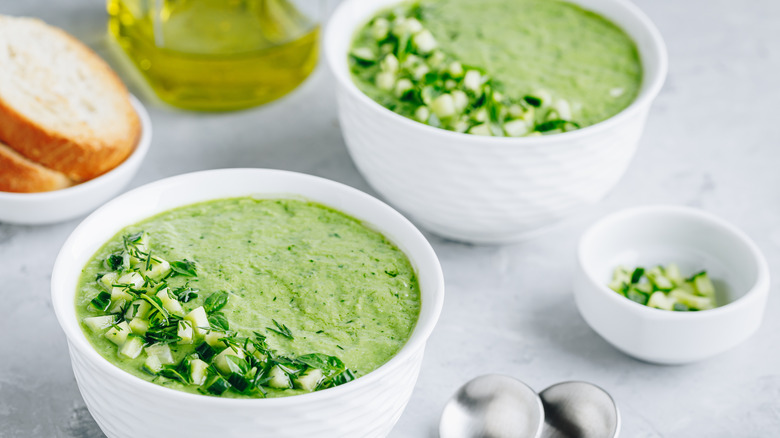What's The Difference Between Red And Green Gazpacho?
When we hear the word "gazpacho," most of us probably think of a Spanish tomato soup that is served cold. Notably, that soup is a vibrant red color. However, there are other varieties of the dish, and whether you're a fan of red gazpacho or not, you should definitely give green gazpacho a try.
The gazpacho that most of us are familiar with is tomato-forward. In most gazpacho recipes, those tomatoes are normally joined by a combination of red wine or sherry vinegar, bell peppers, garlic, olive oil, and salt. Gazpacho often includes bread in some form, sometimes incorporated as a thickener and sometimes simply served on the side. Some variations will add other elements, like cucumber, onion, celery, or even chilis.
But while gazpacho is often synonymous with tomatoes, that's not where the dish comes from. There are varying theories about the origins of gazpacho, but most agree that it arrived in Spain with the Romans or the Greeks, and the word gazpacho comes from the Arabic for "soaked bread." So, if you want to try green gazpacho but worry about losing the tradition of the dish, the bread is more important than the tomato at the end of the day. For green gazpacho, much of the preparation is the same as for red gazpacho but with some notable differences in the ingredients list.
What's in green gazpacho?
There are many variations of green gazpacho. It works from a versatile base, from which you can add a variety of elements to suit your tastes. The central aspect is to remove those ripe red tomatoes and switch in green herbs and vegetables that will keep the freshness we associate with gazpacho while giving it an herbal or vegetal kick.
The tomatoes are typically replaced with combinations of cucumber, green or yellow bell peppers, tomatillos, arugula, or other leafy greens. Plenty of other substitutions are possible as well: avocado for a thicker and creamier touch or honeydew for a lighter, fruity note. Then, you want to add a bunch of herbs. Mint can really deliver on that gazpacho freshness, but other types of herbs will complement the flavors at work here, too.
If you're using avocado, that can help to thicken the green gazpacho without the need for the addition of bread, which makes it ideal if you want to serve green gazpacho with croutons or are aiming for something low-carb or gluten-free.
What about white gazpacho?
It might seem strange to make gazpacho without tomatoes. But variations on gazpacho, especially ones that are different colors, are nothing new. In Spain, you might well come across white gazpacho. Also known as gazpacho Malaga or ajo blanco (white garlic), this pale dish has no bell peppers or tomatoes and instead combines bread and cucumbers with fruit and nuts — typically grapes and almonds — as well as garlic.
White gazpacho might seem a far cry from the green and red versions discussed above, but it harkens back to those Greek and Roman origins, which makes the mix of almonds, grapes, and olive oil all the more understandable. There was a rich tradition around gazpacho in Spain long before tomatoes and peppers were brought over from the New World in the 16th century. Whichever color appeals to you, trying all of them will be a great way to get through the summertime heat with a refreshing, cold soup.


